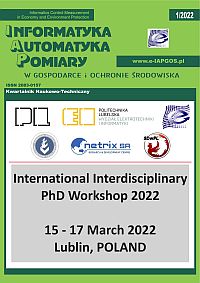ŚWIATŁOWODOWE SKOŚNE SIATKI BRAGGA JAKO CZUJNIKI W POMIARACH WSPÓŁCZYNNIKA ZAŁAMANIA CIECZY
##plugins.themes.bootstrap3.article.sidebar##
Open full text
Numer Tom 12 Nr 1 (2022)
-
METODY ZAPEWNIENIA BEZPIECZEŃSTWA DANYCH W STANDARDACH MOBILNYCH
Serhii Moroz, Anatolii Tkachuk, Mykola Khvyshchun, Stanislav Prystupa, Mykola Yevsiuk4-9
-
HYBRYDOWY SYSTEM NAWIGACJI DO UŻYTKU WEWNĄTRZ POMIESZCZEŃ
Michał Styła, Przemysław Adamkiewicz10-14
-
WEWNĘTRZNY SYSTEM LOKALIZACJI Z WYKORZYSTANIEM UWB
Dominik Gnaś, Przemysław Adamkiewicz15-19
-
ZASTOSOWANIE KONWOLUCYJNYCH SIECI NEURONOWYCH W IDENTYFIKACJI ZAWILGOCEŃ ŚCIAN BUDYNKÓW METODĄ EIT
Grzegorz Kłosowski, Tomasz Rymarczyk20-23
-
ŚWIATŁOWODOWE SKOŚNE SIATKI BRAGGA JAKO CZUJNIKI W POMIARACH WSPÓŁCZYNNIKA ZAŁAMANIA CIECZY
Damian Harasim24-27
-
OPTYMALIZACJA PROCESÓW ZARZĄDZANIA BUDYNKAMI KOMERCYJNYMI Z WYKORZYSTANIEM SYSTEMÓW ANALIZY ZACHOWAŃ UŻYTKOWNIKÓW WSPOMAGANYCH INTELIGENCJĄ OBLICZENIOWĄ I RTI
Michał Styła, Przemysław Adamkiewicz28-35
-
OPRACOWANIE TECHNOLOGII OSADZANIA I POMIARÓW ZMIĘNNOPRĄDOWYCH ULTRACIENKICH WARSTW MIEDZI
Aleksandra Wilczyńska, Karolina Czarnacka, Andrzej Kociubiński, Tomasz Kołtunowicz36-39
-
SIECI NEURONOWE Z KERAS W DIAGNOSTYCE ZMIAN SKÓRNYCH
Magdalena Michalska-Ciekańska40-43
-
OKREŚLANIE DŁUGOŚCI ROBOCZEJ KANAŁU KORZENIOWEGO ZA POMOCĄ SEGMENTACJI RADIOGRAFII WEWNĄTRZUSTNEJ
Oleksii Perepelytsia, Tetyana Nosova44-46
Archiwum
-
Tom 14 Nr 4
2024-12-21 25
-
Tom 14 Nr 3
2024-09-30 24
-
Tom 14 Nr 2
2024-06-30 24
-
Tom 14 Nr 1
2024-03-31 23
-
Tom 13 Nr 4
2023-12-20 24
-
Tom 13 Nr 3
2023-09-30 25
-
Tom 13 Nr 2
2023-06-30 14
-
Tom 13 Nr 1
2023-03-31 12
-
Tom 12 Nr 4
2022-12-30 16
-
Tom 12 Nr 3
2022-09-30 15
-
Tom 12 Nr 2
2022-06-30 16
-
Tom 12 Nr 1
2022-03-31 9
-
Tom 11 Nr 4
2021-12-20 15
-
Tom 11 Nr 3
2021-09-30 10
-
Tom 11 Nr 2
2021-06-30 11
-
Tom 11 Nr 1
2021-03-31 14
-
Tom 10 Nr 4
2020-12-20 16
-
Tom 10 Nr 3
2020-09-30 22
-
Tom 10 Nr 2
2020-06-30 16
-
Tom 10 Nr 1
2020-03-30 19
##plugins.themes.bootstrap3.article.main##
DOI
Authors
Abstrakt
Niniejsza publikacja prezentuje podstawowe założenia dotyczące mechanizmów prowadzenia światła w światłowodowych skośnych siatkach Bragga (ang. tilted fiber Bragg grating), widma transmisyjne światłowodu z wytworzonymi takimi strukturami oraz ich właściwości czujnikowe związane z występowaniem tzw. modów płaszczowych. Prowadzenie światła w postaci modów sprzęganych do płaszcza światłowodu sprawia, że ich właściwości spektralne zależne są od różnicy współczynników załamania ośrodka otaczającego oraz płaszcza włókna. Przy wprowadzeniu niewielkiego kąta pochylenia prążków dyfrakcyjnych tworzących siatkę Bragga, mody płaszczowe wykazują wrażliwość na zmiany współczynnika załamania otoczenia roztworów wodnych, przez co spektrum ich zastosowań jest szerokie. W niniejszej publikacji przedstawiono zmiany widm wybranych modów mierzonych dla roztworów o określonym współczynniku załamania, czułości przesunięcia oraz zmiany współczynnika transmisji modu oraz charakterystyki przetwarzania przy wybranym zakresie stężenia roztworów. Wyniki eksperymentalne wskazują, że mody płaszczowe wysokich rzędów reagują zarówno przesunięciem centralnej długości fali jak również zmianą minimum transmisji. Parametry te w wybranych zakresach wykazują charakterystykę liniową w funkcji zmian stężenia roztworu wodnego cukru trzcinowego. W przypadku TFBG o kącie pochylenia 8°, czułość zmian długości fali wynosi 0,012nm/RIU dla roztworów o stężeniach od 0% do 10% stężenia wagowego.
Słowa kluczowe:
Bibliografia
Bakaic M., Hanna M., Hnatovsky C., Grobnic D., Mihailov S., Zeisler S., Hoehr C.: Fiber-Optic Bragg Gratings for Temperature and Pressure Measurements in Isotope Production Targets for Nuclear Medicine. Applied Sciences 10, 2020, 4610 [http://doi.org/10.3390/app10134610]. DOI: https://doi.org/10.3390/app10134610
Caucheteur C., Mégret P.: Demodulation technique for weakly tilted fiber Bragg grating refractometer. IEEE Photonics Technology Letters 17(12), 2005, 27032705 [http://doi.org/10.1109/LPT.2005.859411]. DOI: https://doi.org/10.1109/LPT.2005.859411
Chettouh S., El-Akrmi A., Triki H., Hamaizi Y.: Spectral properties of nonlinearly chirped fiber Bragg gratings for optical communications. Optik 147, 2017, 163–169 [http://doi.org/10.1016/j.ijleo.2017.08.08]. DOI: https://doi.org/10.1016/j.ijleo.2017.08.085
Erdogan T.: Fiber grating spectra. Journal of Lightwave Technology 15, 1997, 12771294 [http://doi.org/10.1109/50.618322]. DOI: https://doi.org/10.1109/50.618322
Fazzi L., Groves R. M.: Demodulation of a tilted fibre Bragg grating transmission signal using α-shape modified Delaunay triangulation. Measurement 166, 2020, 108197 [http://doi.org/10.1016/j.measurement.2020.108197]. DOI: https://doi.org/10.1016/j.measurement.2020.108197
Gong J. M., Chan C. C., Jin W., MacAlpine J. M. K., Zhang M., Liao Y. B.: Enchancement of wavelength detection accuracy in fiber Bragg grating sensors by using spectrum correlation technique. Optics Communications 212, 2002, 29–33 [http://doi.org/10.1109/OFS.2002.1000525]. DOI: https://doi.org/10.1016/S0030-4018(02)01907-7
Guo T., Liu F., Guan B., Albert J.: Tilted fiber grating mechanical and biochemical sensors. Optics & Laser Technology 78B, 2016, 1933 [http://doi.org/10.1016/j.optlastec.2015.10.007]. DOI: https://doi.org/10.1016/j.optlastec.2015.10.007
Guo T., Tam H. Y., Albert J.: Chirped and tilted fiber Bragg grating edge filter for in-fiber sensor interrogation. Optical Society of America Science and Innovations 2011 [http://doi.org/10.1364/CLEO_SI.2011.CThL3]. DOI: https://doi.org/10.1117/12.884956
Harasim D., Yussupova G.: mprovement of FBG peak wavelength demodulation using digital signal processing algorithms. Proc. SPIE 966212, 2015, 270–276 [http://doi.org/10.1117/12.2205547]. DOI: https://doi.org/10.1117/12.2205547
Liu F., Guo T., Liu J., Zhu X., Liu Y., Guan B., Albert J.: High-sensitive and temperature-self-calibrated tilted fiber grating biological sensing probe. Chinese Sciences Bulletin 58, 2013, 26072611 [http://doi.org/10.1007/s11434-013-5724-3]. DOI: https://doi.org/10.1007/s11434-013-5724-3
Lu Y., Shen C., Chen D., Chu J., Wang Q., Dong X.: Highly sensitive twist sensor based on tilted fiber Bragg grating of polarization-dependent properties. Optical Fiber Technology 20(5), 2014, 491494 [http://doi.org/10.1016/j.yofte.2014.05.011]. DOI: https://doi.org/10.1016/j.yofte.2014.05.011
Mohammed N. A., Ali T. A., Aly M. H.: Evaluation and performance enhancement for accurate FBG temperature sensor measurement with different apodization profiles in single and quasi-distributed DWDM systems. Optics and Lasers in Engineering 55, 2014, 22–34 [http://doi.org/10.1016/j.optlaseng.2013.10.013]. DOI: https://doi.org/10.1016/j.optlaseng.2013.10.013
Ren L., Jia Z., Li H., Song G.: Design and experimental study on FBG hoop-strain sensor in pipeline monitoring. Optical Fiber Technology 20, 2014, 15–23 [http://doi.org/10.1016/j.yofte.2013.11.004]. DOI: https://doi.org/10.1016/j.yofte.2013.11.004
Wydra M., Kisała P., Harasim D., Kacejko P.: Overhead Transmission Line Sag Estimation Using a Simple Optomechanical System with Chirped Fiber Bragg Gratings. Part 1: Preliminary Measurements. Sensors 18(1), 2018, 309 [http://doi.org/10.3390/s18010309]. DOI: https://doi.org/10.3390/s18010309
##plugins.themes.bootstrap3.article.details##
Abstract views: 432
Licencja

Utwór dostępny jest na licencji Creative Commons Uznanie autorstwa – Na tych samych warunkach 4.0 Miedzynarodowe.






